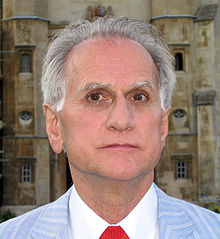- Béla Bollobás
-
Béla Bollobás (* 3. August 1943 in Budapest) ist ein ungarisch-britischer Mathematiker, der sich mit Graphentheorie, Kombinatorik, Perkolationstheorie und Funktionalanalysis beschäftigt.
Inhaltsverzeichnis
Leben und Werk
Bollobás gewann als Schüler zwei Goldmedaillen auf der Internationalen Mathematik Olympiade. Er studierte an der Universität Budapest, wo er 1967 bei Laszlo Fejes Toth und Paul Erdős[1] über diskrete Geometrie promovierte[2]. Danach war er ein Jahr in Moskau bei Israel Gelfand und ein Jahr an der Universität Oxford (Christ Church College), bevor er an die Universität Cambridge ging, wo er 1972 nochmals bei dem Topologen John Frank Adams in Funktionalanalysis promovierte (Banach algebras and the theory of numerical ranges). Seit 1970 ist er Fellow des Trinity College in Cambridge. Seit 1996 ist er Professor an der University of Memphis (Jabie Hardin Chair of Excellence in Combinatorics), blieb aber weiter Fellow des Trinity College, wo er seit 2005 Senior Research Fellow ist. Von 1982 bis 1994 war er regelmäßig an der Louisiana State University in Baton Rouge als Gastprofessor.
Bollobás befasste sich unter anderem mit Graphentheorie (extremale Graphen, Zufallsgraphen, Graphenpolynome), diskreter Geometrie, Funktionalanalysis und der Theorie der Perkolation, wo er Methoden aus der Theorie der Zufallsgraphen anwandte. Er bewies als erster Sätze über die genaue Struktur der Phasenübergänge in Zufallsgraphen, ein Forschungsfeld, auf dem Erdős und Alfréd Rényi in den 1950er Jahren Pioniere waren. Bollobás' Interesse dafür entstand durch Erdős, als dieser zu einem längeren Aufenthalt in Cambridge bei ihm war. Er verfasste über 350 Forschungsartikel und einige Forschungsmonographien (unter anderem über Extremale Graphen 1978, die bis dahin vor allem in Ungarn untersucht wurden, und Zufallsgraphen 1985) und Lehrbücher. Er gab auch John Edensor Littlewoods Mathematicians miscellany in erweiterter Form neu heraus und war Verwalter von Littlewoods schriftlichem Nachlass. Er lernte Littlewood noch in Cambridge kennen, wo seine Frau Gabriella Bollobás, eine Malerin und Bildhauerin, mehrerer Büsten von Dirac herstellte. Bollobas war auch ein Freund von Paul Dirac, dessen Ehefrau Ungarin war (die Schwester von Eugene Paul Wigner).
An der Universität Cambridge (Fechten[3]) und in Oxford (Pentathlon) trat Bollobas auch sportlich hervor.
2007 erhielt er den Senior-Whitehead-Preis. Er ist auswärtiges Mitglied der Ungarischen Akademie der Wissenschaften.
Zu seinen Doktoranden zählen Oliver Riordan, Timothy Gowers und Reinhard Diestel.
Schriften
- Extremal Graph Theory. Academic Press 1978, Dover 2004.
- Graph theory- an introductory course. Springer 1979.
- Random Graphs. Academic Press 1985. Cambridge University Press 2001.
- Combinatorics - set systems, hypergraphs, families of vectors, and combinatorial probability. Cambridge University Press 1986.
- Linear Analysis – an introductory course. Cambridge University Press 1990, 1999.
- mit Alan Baker, András Hajnal (Hrsg.): A tribute to Paul Erdös. Cambridge University Press 1990.
- (Hrsg.): Probabilistic combinatorics and its applications. American Mathematical Society 1991.
- mit Andrew Thomason (Hrsg.): Combinatorics, Geometry and Probability- a tribute to Paul Erdös. Cambridge University Press 1997.
- Modern Graph Theory. Springer 1998.
- (Hrsg.): Contemporary Combinatorics. Springer und Janos Bolyai Mathematical Society, Budapest 2002.
- mit Oliver Riordan: Percolation. Cambridge University Press 2006.
- The Art of Mathematics - Coffee Time in Memphis. Cambridge University Press 2006 (mit Zeichnungen seiner Ehefrau Gabrielle Bollobás)
- mit Robert Kozma, Dezső Miklós: Handbook of Large-Scale Random Networks. Springer 2009.
Literatur
- Graham Brightwell u.a. (Hrsg.): Combinatorics and probability. Celebrating Béla Bollabás’s 60th birthday. Cambridge University Press 2007.
Weblinks
- Literatur von und über Béla Bollobás im Katalog der Deutschen Nationalbibliothek
- Béla Bollobás im Mathematics Genealogy Project
- Konferenz zum 60. Geburtstag von Béla Bollobás
- Interview 2006, Universität Singapur (PDF-Datei; 246 kB)
Anmerkungen
- ↑ Offiziell bei Fejes Toth. Bollobás nennt Erdős in einem Interview 2006 seinen „wahren Doktorvater“, den er seit dem Alter von 14 Jahren kannte (Erdős lud ihn ein, nachdem er den nationalen Mathematikwettbewerb gewann) und mit dem er seitdem häufig korrespondierte und mit Problemen „versorgt“ wurde. Er publizierte mit Erdős noch als Schüler.
- ↑ Außerdem war er als Student ein Jahr in Cambridge, auf Empfehlung von Erdős
- ↑ Er betrieb diesen Sport schon in Ungarn, wo es in höheren Kreisen eine Art Nationalsport war. Sein Großonkel hatte eine Fechtakademie
Wikimedia Foundation.

